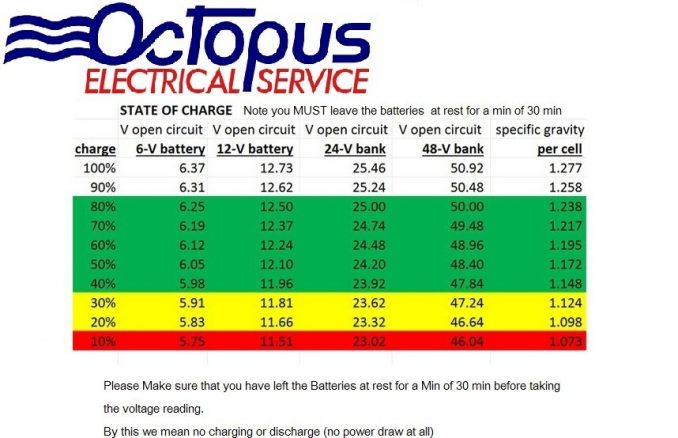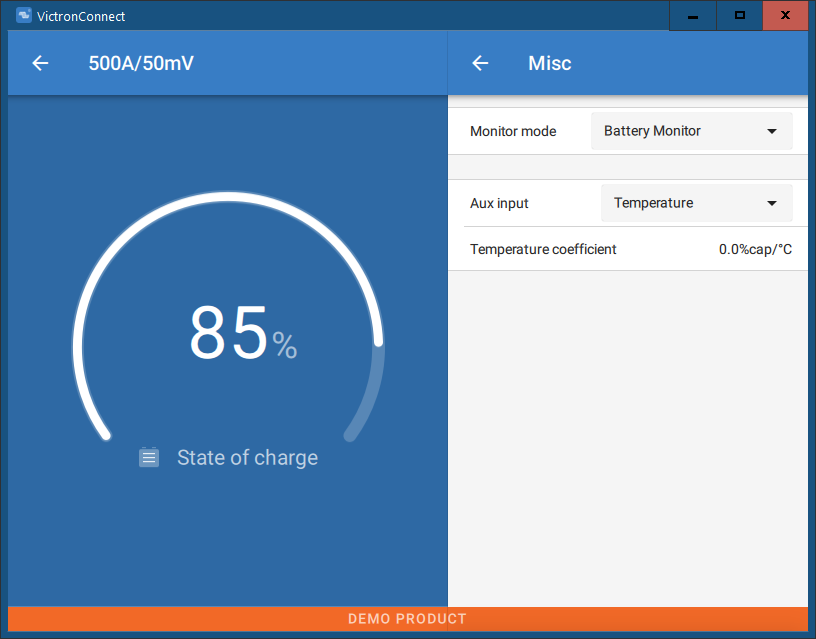Hello, I repeat a question that I have already asked in a simpler way, because I did not get an answer. I have a Victronenergy AGm deep cycle 110ah for 7/8 months. Since November I have noticed a drop in ocv (OPEN CIRCUIT VOLTAGE) of 0.07 / 0.08v for each discharge. For instance: Previously with a discharge of - 6ah it had ocv 13.00 / 12.97v, Now 12.93 / 12.94v. before with discharge of - 12ah it had ocv 12.88 / 12.91v Now it has 12.80 / 12.83v. Previously with a discharge of - 20ah it had 12.73 / 12.75v ocv. Now 12.66 / 12.68v. This decline happened in November. For the first 6 months in the summer, the ocv remained constant. The battery is recharged every day to 100% with the parameters of the victronenergy datasheet (abs voltage 14.4 / 14.5v, float 13.8v, abs time 1-3 hours, temperature coefficient - 24mV / C °). The only thing that has changed is the temperature. Before it was on average 27/30 C °. From November on average it is 20 / 22C °. For more detailed information on the conditions of use of the battery read here: https://community.victronenergy.com/questions/111143/victronenergy-agm-deep-cycle-performance-and-boost.html Is this voltage drop normal? Is it the temperature? Or is the battery sulfating? Thanks
- Home
- Anonymous
- Sign in
- Create
- Spaces
- Grafana
- Node-Red
- Unsupported topics
- Questions & Answers
- Modifications
- Communauté francophone
- Deutschsprachiger Bereich
- Preguntas en Español
- Explore
- Topics
- Questions
- Ideas
- Articles
- Badges
question
Victronenergy Agm deep cycle voltage drop after 7 months
A normal full gel ocv is around 12.7 to 12.8 vfor 100% SOC and a temp drop would also affect it a lot as well. the below is a average SOC Voltage chart at 25 deg C

Now is 13.10v.
Maybe is temperature. Maybe it stabilize at a slightly lower ocv with use.
I now that the first 2/3 months of use, capacity increase slightly and then stabilize.
Are my battery performance normal for you?
Temperature.
Capacity is defined at 25°C. Warmer batteries have more capacity. Colder batteries have less capacity.
-X Ah @ 27/30°C is a different % DoD than at 20/22°C
The -24mV/°C is for charge voltage temperature compensation, i.e., 14.4V is defined at 25°C. At lower temps, absorption voltage needs to be HIGHER than 14.4V to get fully charged. Above 25°C voltage needs to be lower.
Have you programmed your charger with this temperature compensation value?
Example only, not necessarily absolutely accurate:
A 6Ah discharge BELOW 25°C might be 22% DoD while it's 18% DoD at 30°C.
Thus the greater DoD in cold would result in a lower resting voltage.
The smartshunt allows setting a parameter to adjust capacity based on temperature in Misc:

My particular FLA batteries are -1.1%/°C, but that varies with manufacturer and type.
Halló, thanks you. Yes I programmed my mppt charger exactly with datasheet victronenergy parameters.
Abs 14.4v/14.5v. Temp coefficient - 24mv/C. Float 13.8v. Abs time from 1 to 2 hours depending of dod. My average dod is 15/20% daily.
One time per month I make 3 hours abs at 14.6v (a slightly equalization becouse is a vrla battery). Is unnecessary or dangerous?
You say:"X Ah @ 27/30°C is a different % DoD than at 20/22°C"
I agree with you, but I think these not justified a 0.08v drop in ocv.
A loss of 4% of capacity from 30 to 20 C Celsius, is not a 0.08v drop in ocv with same Ah discharge. It would be less.
I'm wrong?
I now all waht you say about cold and internal resistance and capacity drop. Thank you for your reply.
Are you allowing a full 24 hours of static rest before recording OCV readings? If not, it is even more unreliable.
All evidence points to reduced capacity associated with reduced temperatures and failing to compensate for that.
Yes The Ocv must be measured 24 hours after recharging due to the "plate charge" which must be eliminated. But it only takes 20 minutes after a discharge to have a 100% reliable ocv. After 20 minutes the ocv not increase anymore and is stable. Try to believe. All my 300 data were taken with care and under the same conditions (20 minutes after discharge, always at the same C rate of discharge). Only the temperature has changed slightly. If I tell you that the ocv has decreased by 0.07 / 0.08v, it means that it is so. I have not taken a single data and drawn a conclusion. I've looked at a trend with hundreds of repeat identical tests. And I have established an evident trend: since November the ocv of my battery has dropped by an average of 0.07 / 0.08v for each discharge. This is the fact and I am trying to investigate why.
Related Resources
MPPT 150/60 up to 250/70 Manual
Additional resources still need to be added for this topic
question details
57 People are following this question.
